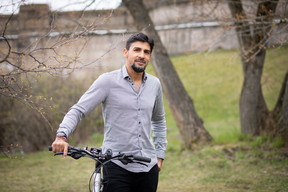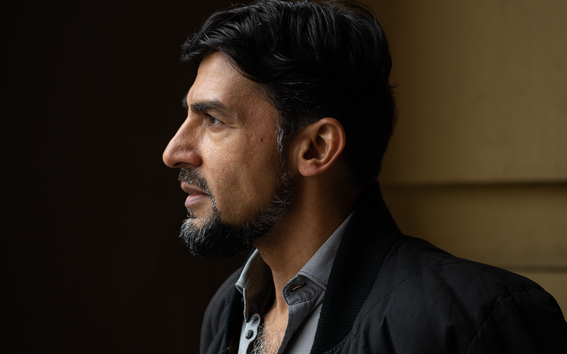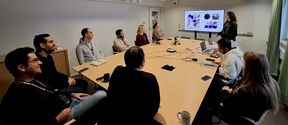Engaging the social and political in designing technologies

Professor of Practice Nitin Sawhney joined Aalto University in extraordinary times, as he arrived to Helsinki from New York with his partner in the midst of an emerging global pandemic. As countries began closing their borders and Aalto University shifted to remote work and teaching, Sawhney hardly had time to ponder how this crisis would impact their relocation to the Nordics.
Despite the exceptional start at Aalto, he seems grateful. ‘On every level, we have been so fortunate in this situation, and I can’t say enough about how well the Finnish system has functioned for us,’ Sawhney says. As an academic researcher Sawhney’s residence permit was approved by Finnish migration services in less than 10 days, which normally takes far longer. Having visited Helsinki several times previously, Sawhney had an opportunity to get to know many of his faculty colleagues at Aalto.
This made the inevitable, physically-distanced interactions with colleagues over Zoom this spring far less awkward for Sawhney. ‘I already feel very connected to the Aalto community and I know there will be many more opportunities to continue building this network now that I’m here,’ he adds.
Computer science combined with media and arts
Crisis has been a part of Sawhney’s life even as a child when his family was forced to leave Tehran, Iran in the midst of a revolution in the late 1970s to move back to New Delhi, India, where he was born. Returning to live in the Middle East and across the U.S. for most of his life clearly shaped Sawhney’s worldview. ‘When you’re around and grow up in these places, you recognize the world is a complicated place and that technology has a crucial role, but we need to take many social and political aspects into account.’
Nitin SawhneyThe world is a complicated place and technology has a crucial role, but we need to take many social and political aspects into account
Sawhney trained in computer science and engineering but has gained experience in media, documentary film, design, arts, and activism through his varied life experiences. He completed his doctoral studies at the Massachusetts Institute of Technology (MIT) in 2003, while conducting research at the MIT Media Lab in speech interaction, wearable computing, and distributed design collaboration.
After finishing his PhD, Sawhney co-founded Akaza Research, a software startup to develop open source platforms for clinical data repositories. He later led new product development for Cytel Inc., on statistical simulation tools to support adaptive clinical trials. ‘Working in industry I tried to promote open access principles, interoperability standards and novel business models to support partnerships for public biomedical research, but the pace of such innovations and practices can take a very long time to be adopted,’ he says.
The transdisciplinary ethos and international orientation made Aalto an attractive option
Sawhney has since collaborated with many artists, activists and social scientists which greatly challenged his perspective. ‘I realized that my own sensibility has been transformed by engaging with seemingly intractable problems in society in somewhat unexpected ways. Arts, design, humanities, and political activism can be integral to how we as computer scientists make sense of and act in the world,' he adds.
This is what led Sawhney to take up a faculty position at The New School in New York in 2011 and collaborate with colleagues across disciplines in social science research and at the Parsons School of Design. Whether conducting research around social movements like Occupy Wall Street, tactical urban design in Moscow or devising participatory civic media projects with marginalized youth in Palestinian refugee camps, Sawhney engaged the design of collaborative digital platforms with participatory action research among communities in crisis or contested spaces.
The transdisciplinary ethos and an international orientation are also what drew Sawhney to join Aalto University. He found Aalto attractive because it’s an environment where science, engineering, arts and design, are more easily infused in people’s work. ‘I want to explore things that the Nordics have done well, particularly in terms of participatory design, social equity and sustainability. Obviously, Finland has also been an important research and technology hub since the days of Nokia.’
Nitin SawhneyI want to explore things that the Nordics have done well
Sawhney also had a more personal link to Aalto. While at MIT, he advised the PhD thesis of Teemu Leinonen who is now an Associate Professor of New Media Design and Learning at Aalto. ‘We kept in touch over the years. When I was thinking about Aalto, Teemu was very encouraging; he invited me to stay at his home and was able to connect me with the Aalto community informally. That made me feel comfortable at Aalto right away.’
Researchers should collectively seek solutions for the biggest crises for the globe
In the computer science context, while Human-Computer Interaction (HCI) remains his core research area, Sawhney plans to expand his prior work in participatory design with children, multi-modal voice-based interaction, and cooperative Human-AI systems in crisis response.
Sawhney says he hopes to push himself and his students to consider how we can contribute to collectively understanding and designing for seemingly intractable problems. ‘I feel like climate change, besides this pandemic, is one of the biggest crises for the globe and our future, and if we are not finding a way to collectively address this crisis, I don’t know how we are going to be valuable.’
This summer Sawhney plans to already begin teaching online at Aalto, including a special topics course on ‘Human-Centred Research and Design in Crisis.’ He hopes that students will develop a deeper understanding of how to conduct research and design for technological innovations in complex crisis contexts, while examining their ethical implications, including with the current COVID-19 pandemic. ‘The course will offer students opportunities to engage industry and organizational partners in the city and elsewhere, but also help us as a faculty to develop socially engaged curricula that we can expand in future courses.’
Sawhney says he has settled in well in Helsinki, but will surely miss his life in Brooklyn, New York. ‘We lived right by Prospect Park, which is almost like the Central Park of Brooklyn. I would go running in the park almost every day and I was very involved in the community.’
He speaks highly of the vibrant social and cultural atmosphere of Brooklyn, its diverse people, arts exhibitions, community gardens, and activism. ‘I imagine these things are also present in Helsinki, so I’m very much looking forward to finding those kinds of eclectic arts spaces, participatory communities, and critical engagement here too.’
He hopes that he and his partner will keep their connections in New York alive, and bring some aspects of New York to Helsinki and Aalto. ‘Some of the case studies I might share in my courses and guest speakers I invite, would inevitably highlight experiences of the critical struggles and creative responses among the many crises New York City has confronted.’

Nitin Sawhney, Professor of Practice
Education: PhD in Media Arts and Sciences from the Massachusetts Institute of Technology
Lives in Helsinki
Was born in New Delhi, India, but feels at home also in Cambridge, Massachusetts, and Brooklyn, New York
Greatest professional accomplishment: Running a startup company and transforming his dissertation research into a practical context, creating significant public impact. ‘It was a key moment for me to leave academia, create a high-risk startup, build a team, and develop open source software platforms with a viable business model to sustain it. The lessons from this experience have shaped how I manage research projects and industry partnerships.’
Greatest non-professional achievement: Establishing Voices Beyond Walls, a program for participatory media, youth training, and community-based research in Palestinian refugee camps. ‘It was probably the hardest thing I’ve done in a non-academic context; each summer for five or six years I led a team of artists, educators and social workers to develop the programs and evaluated their impact. It helped me develop a socially-engaged pedagogical practice.’
Has also
Taken a one-month expedition in the Himalayas. ‘I hiked and camped with artists, scholars and writers on a historic pilgrimage route from Nepal to Tibet. It was a very transformative moment to explore this world and the role of sacred in people’s lives. Along the way, I recorded the sounds of the landscapes and monks chanting. After the trip, I devised an art installation with a soundscape where people could walk on Himalayan salt.’
Made a documentary film with children in Gaza. ‘While working in Gaza, I decided to make a film on the role of kite making and flying on the lives of children. Not having a production crew, I trained a group children on filmmaking and we made the film together. It became such a joyful project, as they captured the lives of other kids in such humorous and authentic ways; all this is reflected in the film, Flying Paper, which has been widely seen.’
Been constantly confused with his namesake, musician Nitin Sawhney. ‘He became very popular in the nineties, and I would mistakenly receive his fan mail all the time. But one day he emailed me out of the blue to tell me about his experience. For a concert he was performing with Sting in France, the publicity posters accidently used the wrong person’s image. I never received a copy of that poster with me and Sting! But my namesake kept in touch with me and after I finished my documentary in Gaza, he produced the soundtrack for it. When the film premiered in London, audiences were even more confused with the credits.’
Further information:
Read more news
Apply to be a guest professor or visiting researcher at the Université Grenoble Alpes
Unite! partner, Université Grenoble Alpes (UGA) has opened a call to host international professors and researchers for short stays.
Floriane presents research findings on denim recycling
On 15 January 2026, Floriane Jacquin, an intern with the Textile Chemistry Group at Aalto University, presented the findings.
Postdoctoral researcher Eloi Moliner makes history as a 5-time award winner
Eloi Moliner is one of the most decorated doctoral researchers in Aalto University's history – we would like to highlight his success and contributions to the field of audio signal processing






